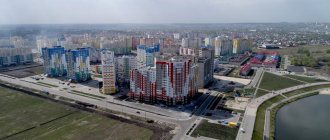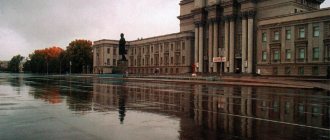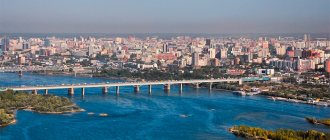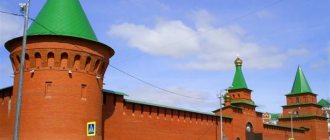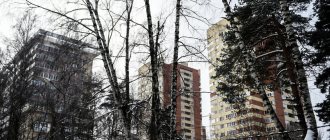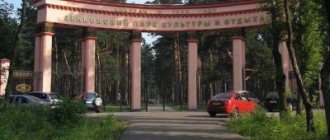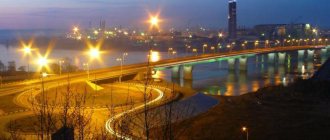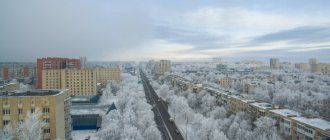Celebrations in honor of the memorable date take place on central streets, squares and parks. On this day, it is customary to open the erected structures, with the participation of the city administration. Children's works are presented in cultural institutions: drawings, crafts. A fair of decorative and applied arts is held. Folk craftsmen share their accumulated experience with event visitors.
Creative teams demonstrate performances. There are attractions and animators for younger audiences. Theaters are preparing open-air performances. Sports competitions determine the strongest in basketball, football, and athletics. Popular performers take the stage. The final chord of the holiday is fireworks.
In 2021, Novomoskovsk City Day is celebrated on May 29. For a long time it was celebrated in September, but in 2013 the date was moved to the last Saturday of May.
City information
Novomoskovsk (before 1933 – Bobriki; from 1933 to 1961 – Stalinogorsk) is the center of the municipal formation of the same name in the Tula region. Located in the west of the Russian Federation. Located between the Shat and Don rivers (at its source). The economy is represented by energy generating, chemical, construction, manufacturing, and food enterprises.
The federal highways M4 Don and P132 pass through the settlement. The railway line is operational. There are universities and their branches, secondary specialized educational institutions. The ecological situation poses a danger to the environment due to emissions of harmful substances into the atmosphere.
OUR REFERENCE Novomoskovsk arose as the village of Bobriki, and in 1930 received the status of a city. From 1934 to 1961 it was called Stalinogorsk (until 1945 it was the capital of the territorial region of Mosbass as part of the Moscow region, after which it became part of the Tula region), and in 1961 it received its modern name - Novomoskovsk. The city owes its appearance to the construction of the chemical giant NPO Azot (now NAC Azot), as well as the development of the Moscow Region coal basin. In 2007, Novomoskovsk won the All-Russian Golden Ruble competition as the most economically developed among large cities.
LOCATION 888 sq. km is the area of the city. 236 m - at this height above sea level the city is located and is located at the highest point of the Central Russian Upland. 55 km to the southeast - this is how Novomoskovsk is located relative to Tula.
IMPROVEMENT of 7 microdistricts. More than 100 streets, parks and squares. 2 parks of culture and recreation. 4 times over the past 10 years, Novomoskovsk has been among the top three according to the results of the All-Russian competition for landscaping and gardening.
POPULATION 160 thousand people live in Novomoskovsk, of which: 70 thousand children and adolescents under the age of 20, 50 thousand middle-aged - from 20 to 55 years, 40 thousand people over 55 years old.
INDUSTRY More than 100 industrial enterprises and construction organizations. More than 20 billion rubles - the volume of industrial production. 37.39 billion rubles. — value of exported goods in 2007
Each city has its own “calling” card. Novomoskovsk has several of them at once! This city has a lot to see for visitors. Judge for yourself.
· Children's railway, the only one in the Central part of Russia. Here, starting from the 5th grade, children study railway specialties and work in real railway uniform as drivers and station masters. Anyone can ride the railway. The length of the road is 2.3 km, there are 3 stations: “Berezki”, “Pionerskaya” and “Source of the Don River”. There is a section along the way where the “children’s” train runs side by side with the real one.
· The Don begins in Novomoskovsk.
· Near Novomoskovsk there is the Pronsky Reservoir, the largest and deepest in the region: its length is 26 km, width - 2 km, depth up to 25 m. The area of the reservoir is 1620 hectares.
· Unique boulevards between the roadways of Moskovskaya and Komsomolskaya streets - there are no such boulevards in any city in the Tula region.
BY THE WAY STAR PEOPLE OF NOVOMOSKOVSK
Vsevolod Rudnev (1855-1913). Hero of the Russian-Japanese War, rear admiral of the Russian Imperial Navy, commander of the cruiser "Varyag". The Rudnev family owned an estate near the village. Yatskaya, Venevsky district (now Novomoskovsky district). Vasily Starodubtsev, ex-governor of the Tula region. He worked in Novomoskovsk: from 1955 - a bulk fastener, a mechanic-driver of mining machines at mine No. 36 of the Stalinogorskugol trust, in 1964-1997. - Chairman of the collective farm named after. Lenin. Irina Saltykova, singer and actress. Born on May 5, 1966 in Novomoskovsk. Graduated from school No. 20, construction technical school in Novomoskovsk. Olga Vatlina, singer, soloist of the group “Assorted”. Born on July 29, 1983 in Novomoskovsk. Graduated from Novomoskovsk General Education Lyceum. Ksenia Semenova, gymnast, world and European champion, participant of the Olympic Games in Beijing 2008. Born on October 20, 1992 in Novomoskovsk.
From the history of Novomoskovsk: monument to soldiers of the 172nd Infantry Division
Near the building of special (correctional) boarding school No. 2 for orphans and children left without parental care, located on Pionerskaya Street, there is a monument to the soldiers of the 172nd Infantry Division, which was formed during the Great Patriotic War in our city.
On a low pedestal there is a stone slab with a relief image of a soldier’s face. On the pedestal there is a memorial plaque with the text: “To the soldiers of the 172nd Infantry Division.” An entire regiment of the 172nd Infantry Division was formed from Stalinogorsk conscripts and provided with Tula weapons. The same one that became famous in the great confrontation near Mogilev, became the Red Banner and bears the same name as the liberated city and went through the battle route from Stalinogorsk to Prague.
The 172nd Rifle Division was formed in September 1939 on the territory of the Tula region. Its headquarters were located in Stalinogorsk. The division included many Tula and Stalinogorsk residents. Among them are fellow countrymen V.P. Kuznetsov, A.I. Parshin, F.I. Pashanin, who gave their lives in the name of saving others. The division was then commanded by M. T. Romanov. In 1940, a military unit was sent to the Finnish front, and in early July 1941 received orders to defend the city of Mogilev in Belarus. She thinned out a lot after these fights.
In August 1941, the division was already under the command of I.A. Laskina again wages successful battles in the Crimea and for 8 months participates in the heroic defense of Sevastopol. In September 1942, new reinforcements to the division took place in Dorokhov and Kubinka near Moscow. And again this division is fighting. In November, its soldiers crossed the Dnieper. In 1943, the division fought 400 kilometers, liberating 150 settlements from the Germans. In May 1945, she crossed the Elbe and marched to Prague. For all its exploits, the division was awarded the Order of Suvorov, II degree, Order of the Red Banner of Battle, and Order of Bogdan Khmelnitsky.
The monument in Novomoskovsk was opened on the 20th anniversary of the Great Victory in 1965. Over the years, his condition has, of course, been poor, to put it mildly. But the educational institution did not have funds for restoration. The initiative to bring the monument into proper shape was taken by Honorary Citizen of Novomoskovsk V.A. Bogomolov. Soon a sponsor was found - ZAO Spetsmontazhnaladka.
On November 6, 2021, on the territory of the Novomoskovsk Regional Education Center, after restoration, the monument to the 172nd Infantry Division was solemnly opened.
On 11/06/2018, a ceremony was held, at which official guests came to the pupils of the education center: Vitaly Bogomolov, head of the municipality of the city Anatoly Prorokov, Honored Energy Engineer of the Russian Federation Gennady Kochetkov, General Director of the company sponsoring the reconstruction of JSC Spetsmontazhnaladka Alexey Kleimenov, representatives of the city council of veterans war, labor, armed forces and law enforcement agencies Yuri Ryzhkov and Viktor Linyaev.
The head of the municipality opened the ceremony. “The fate of the 172nd Rifle Division is an important historical event for Novomoskovsk,” said Anatoly Prorokov. “Despite the fact that the division of the first formation did not fight for long, it was a bright, legendary story of heroes.” The opening monument is not the first reminder of our city’s connection with the courageous soldiers of the 172nd Infantry Division, he emphasized. Last year, a memorial plaque was unveiled at house No. 19-b on Moskovskaya Street in honor of division commander Yakov Kreizer. From October 1939 to January 1940, this building housed the command staff of the 172nd Infantry Division. In addition, Kreiser became the first commander of a rifle division to earn the title of Hero of the Soviet Union just a month after the start of the war.
The guests spoke in their speeches about the significance of the current event - the reconstruction of the monument to the soldiers of the 172nd Infantry Division - in preserving the history of the country and the moral and patriotic education of young people. On behalf of the center’s management and its students, the center’s deputy director, Alexander Reutov, thanked the team of the sponsoring enterprise and the municipal administration for the work carried out.
A mournful minute of silence and a three-shot rifle shot served as a tribute to the fallen soldiers after the monument was inaugurated. Now the children who study at this center have a wonderful place for holding patriotic events and laying flowers on significant dates associated with the Great Patriotic War.
Students and teachers of the Novomoskovsk Regional Education Center painstakingly collect material about the combat path of the famous 172nd Infantry Division, which was formed in our city, and the monument erected near the walls of the school is a tribute to the memory of its brave warriors.
Opening of the monument to the 172nd Infantry Division
Story
The history of Novomoskovsk begins in the 18th century, from the village of Bobriki. It was formed on the basis of the estate of a noble family of descendants of Count Orlov and Empress Catherine II. The city was founded after the arrival of Soviet power, in 1930. It owes its appearance to the construction of one of the largest chemical plants and the development of a coal deposit. It began to experience rapid population growth. Infrastructure has appeared: cultural, educational, medical institutions.
During the Second World War it was occupied and severely destroyed. After its completion, it was restored and new areas were laid out in it. In 1957 it became part of the Tula region. In 1961 it received its modern name. He was exposed to radioactive contamination as a result of the accident at the Chernobyl nuclear power plant. In the first decade, the Russian Federation experienced stagnation.
Novomoskovsk - a brief history of the city
It appears on the site of the estate of the descendants of Orlov and Catherine II, Bobriks, who were born out of wedlock. Briefly, in 1765
The empress, together with Bogoroditsky, fully owns the village. As an administrative unit it is included in the Epifansky district of the Tula province.
The beginning of the story
Operating under this name with 1765
to 1930, in
the 1930s turns into the center of industry, the capital of Mosbass as part of the Moscow region thanks to: o NPO "Azot". o Coal mining basin. At the same time, a powerful infrastructure is being built. Seriously destroyed during the Nazi occupation, it is quickly restored and becomes part of the Tula region - the second most important after it. The appearance and cultural environment are significantly influenced by research in science and chemistry.
Stages of development
Difficult economic situation 1990-
x years
requires updating, for which a public-private investment project is being developed, which involves from 2007
to 2021: o Construction and modernization.
o Expansion of the transport network. o Conditions for further growth. In 2008
, as a newly formed district, it united
113
settlements of the abolished Novomoskovsky district with the inclusion of Sokolniki.
Bobriki village
The Bobrinskys are located here, owning many villages with a number of residents approaching 80
%
of the population of the future district. Vast areas are occupied by landowners and Baron Megden. The following from the illegitimate son have survived to this day: • Spasskaya Church. • Tomb of the counts • Manor park, dating back to the landscape architecture of the 18th-19th centuries. • Nowadays the historical and memorial museum complex of the same name welcomes visitors.
Prerequisites
Taking in 1920-
x years
a course to accelerate the process of industrialization, the abandonment of the ideas of the NEP was required by the industry. In 1928
, a program for raw materials and supplies was adopted.
Agriculture is in dire need of fertilizers. After research activities for location, the Uzlovsky district was chosen due to its wealth of natural resources: Coal reserves - more than 160
million tons. Gypsum - about
500
million tons. Red and refractory clay - 11.5 million tons. Table salt. Water for the needs of the rivers Shat, Don with the tributary of Lyubovka and Ivan Lake.
Renaming
The chemical plant is one of the significant and complex construction sites of the five-year plan 1928
- 1932, which attracted enthusiasts from all over the USSR.
The work is often done manually using shovels, wheelbarrows and stretchers. The displaced people live in 1,000
dugouts, barracks and plywood temporary huts.
IN 1933
d. products begin to be supplied to the market. Distinguished employees are awarded the following orders: 6 participants of the highest at that time - Lenin. 12 - Labor Banner.
The Commissariat, headed by Sergo Ordzhonikidze, proposes to appropriate Stalinogorsk in honor of the Secretary of the Central Committee of the All-Union Communist Party (Bolsheviks) I.V. Stalin.
December
27 , the request is also fulfilled in relation to the plant.
Already next year, another facility will open - for the production of phenols, known as Orgsintez LLC. It produces organic semi-products, eliminating the need for supplies from abroad. The production of the chemical plant in 1941
, which made it a leader in the Union and in the world, reaches per year: 40,000 tons of ammonium nitrate. 3000 tons - sodium nitrate. 40,000 tons - sulfuric acid. 8,500 tons - caustic soda. 15000 tons - bleach. 240,000 tons - fertilizers.
There are 18
species.
Qualified personnel were required, and therefore in 1931
a factory school was organized - FZU, which accepted
200
teenagers, many of whom subsequently continued their studies at the Nizhny Novgorod State Technical University.
In the same year, the chemical technical school opened its doors to students, training 81
specialists.
Before the start of the war, diplomas were issued 800
graduates.
Current state
The coat of arms contained an image of a beaver, reminiscent of the former noble family. City Day is celebrated on the last Saturday of May, on the eve of Chemist's Day. Athletes certainly take part in wide, cheerful festivities, demonstrating excellent results. It cannot be done without a festive parade of groups and a concert held in the evening at the Khimik stadium with the obligatory final fireworks display.
Coat of arms
The coat of arms of Novomoskovsk is presented in the form of a French shield. The red background at the top shows a golden hammer on top of two silver pickaxes in a criss-cross pattern. Below on three green hills lie golden amphorae overturned and facing each other. Silver streams pour out of the vessels. An optional element is to decorate the shield with the ribbon of the Order of the Red Banner of Labor.
The artistic composition was approved on March 24, 1999 by decision of the Council of Deputies of the municipality of Novomoskovsk No. 27-1. Included in the State Heraldic Register of the Russian Federation under No. 454. The author of the coat of arms is Honored Artist of the Russian Federation M. Shelkovenko.
Hymn
There are many famous cities in the world. Everyone has their own path, history and growth. Your shrines. But, to be honest, there is no better place than my Novomoskovsk!
Chorus:
Grow, my city, a corner of Russia, In the crown of parks, squares and gardens. Be the youngest under the blue sky From the youngest of our cities!
The beauty of Great Rus', the quiet Don, flows free and wide, but only here, with us, are its origins, in my unique city.
Chorus:
Grow, my city, a corner of Russia, In the crown of parks, squares and gardens. Be the youngest under the blue sky From the youngest of our cities!
You are not the capital of either a country or a region, But you are unique in your destiny. And every evening the heart skips a beat, And longs for the songs of your streets.
Words by V. Kireev, music by S. Igolnitsyn.
Approved on July 24, 2009.

